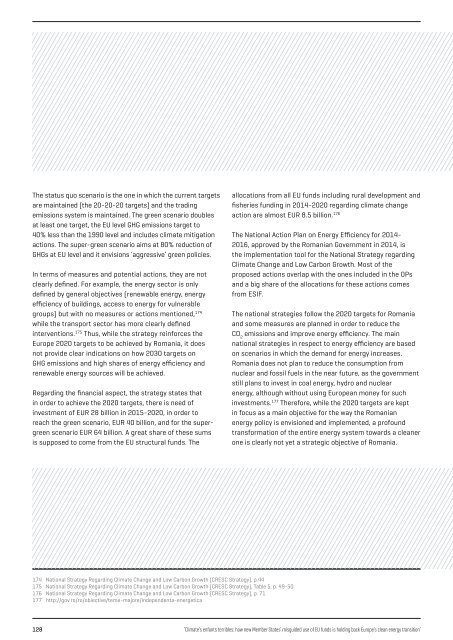ENFANTS TERRIBLES
enfants-terribles
enfants-terribles
You also want an ePaper? Increase the reach of your titles
YUMPU automatically turns print PDFs into web optimized ePapers that Google loves.
The status quo scenario is the one in which the current targets<br />
are maintained (the 20-20-20 targets) and the trading<br />
emissions system is maintained. The green scenario doubles<br />
at least one target, the EU level GHG emissions target to<br />
40% less than the 1990 level and includes climate mitigation<br />
actions. The super-green scenario aims at 80% reduction of<br />
GHGs at EU level and it envisions ‘aggressive’ green policies.<br />
In terms of measures and potential actions, they are not<br />
clearly defined. For example, the energy sector is only<br />
defined by general objectives (renewable energy, energy<br />
efficiency of buildings, access to energy for vulnerable<br />
groups) but with no measures or actions mentioned, 174<br />
while the transport sector has more clearly defined<br />
interventions. 175 Thus, while the strategy reinforces the<br />
Europe 2020 targets to be achieved by Romania, it does<br />
not provide clear indications on how 2030 targets on<br />
GHG emissions and high shares of energy efficiency and<br />
renewable energy sources will be achieved.<br />
Regarding the financial aspect, the strategy states that<br />
in order to achieve the 2020 targets, there is need of<br />
investment of EUR 28 billion in 2015-2020, in order to<br />
reach the green scenario, EUR 40 billion, and for the supergreen<br />
scenario EUR 64 billion. A great share of these sums<br />
is supposed to come from the EU structural funds. The<br />
allocations from all EU funds including rural development and<br />
fisheries funding in 2014-2020 regarding climate change<br />
action are almost EUR 8.5 billion. 176<br />
The National Action Plan on Energy Efficiency for 2014-<br />
2016, approved by the Romanian Government in 2014, is<br />
the implementation tool for the National Strategy regarding<br />
Climate Change and Low Carbon Growth. Most of the<br />
proposed actions overlap with the ones included in the OPs<br />
and a big share of the allocations for these actions comes<br />
from ESIF.<br />
The national strategies follow the 2020 targets for Romania<br />
and some measures are planned in order to reduce the<br />
CO 2<br />
emissions and improve energy efficiency. The main<br />
national strategies in respect to energy efficiency are based<br />
on scenarios in which the demand for energy increases.<br />
Romania does not plan to reduce the consumption from<br />
nuclear and fossil fuels in the near future, as the government<br />
still plans to invest in coal energy, hydro and nuclear<br />
energy, although without using European money for such<br />
investments. 177 Therefore, while the 2020 targets are kept<br />
in focus as a main objective for the way the Romanian<br />
energy policy is envisioned and implemented, a profound<br />
transformation of the entire energy system towards a cleaner<br />
one is clearly not yet a strategic objective of Romania.<br />
174<br />
175<br />
176<br />
177<br />
National Strategy Regarding Climate Change and Low Carbon Growth (CRESC Strategy), p.44<br />
National Strategy Regarding Climate Change and Low Carbon Growth (CRESC Strategy), Table 5, p. 49-50<br />
National Strategy Regarding Climate Change and Low Carbon Growth (CRESC Strategy), p. 71<br />
http://gov.ro/ro/obiective/teme-majore/independenta-energetica<br />
128<br />
‘Climate’s enfants terribles: how new Member States’ misguided use of EU funds is holding back Europe’s clean energy transition’


